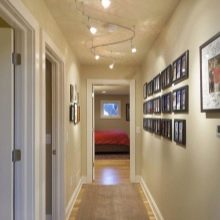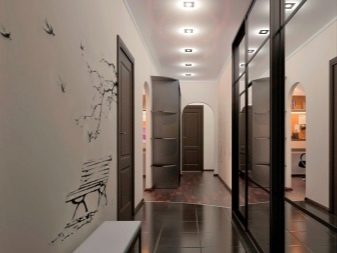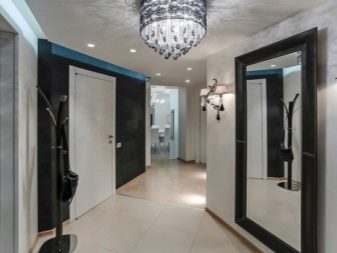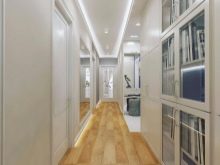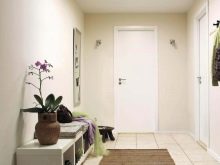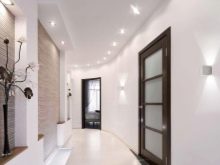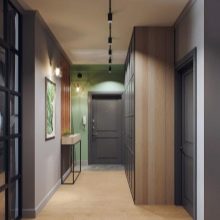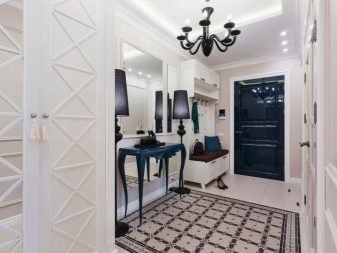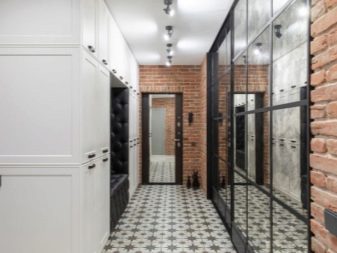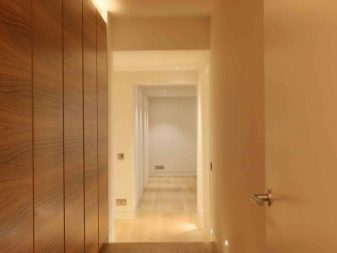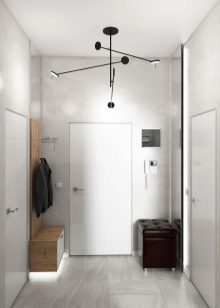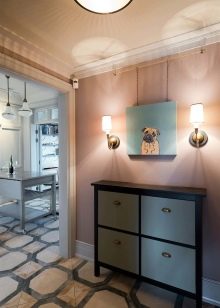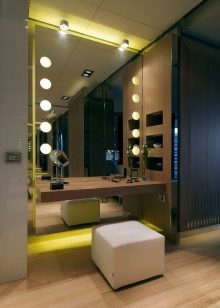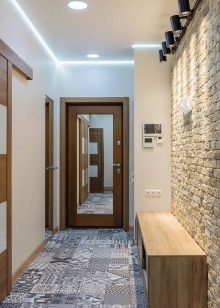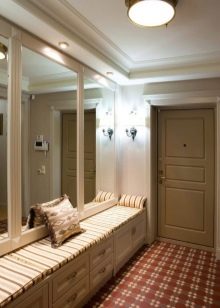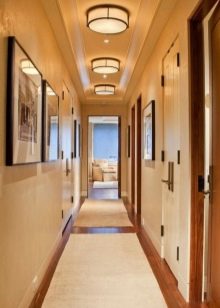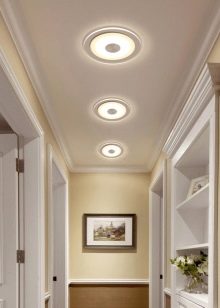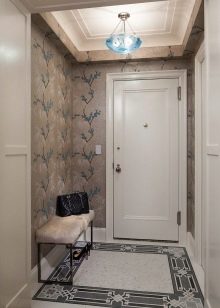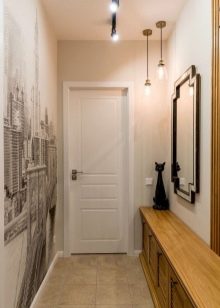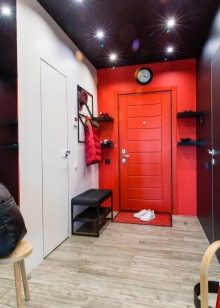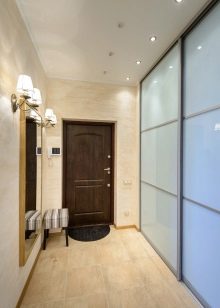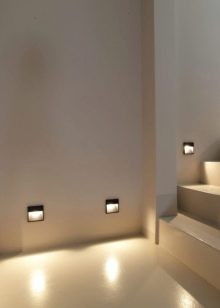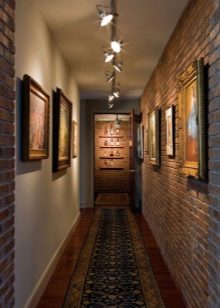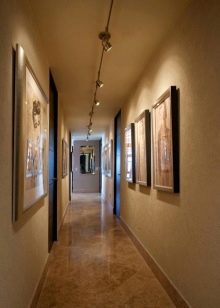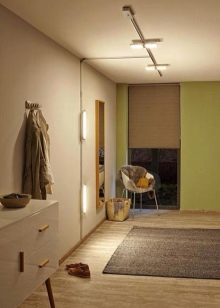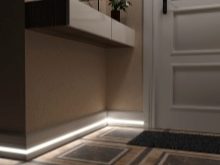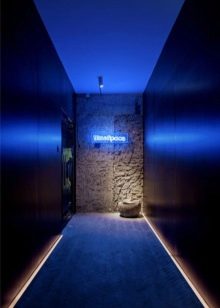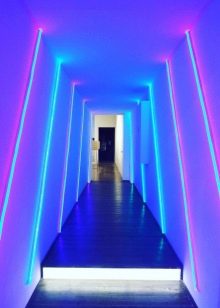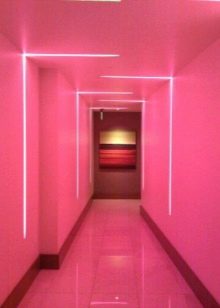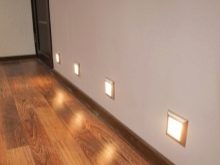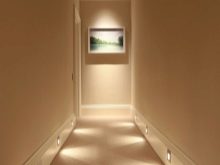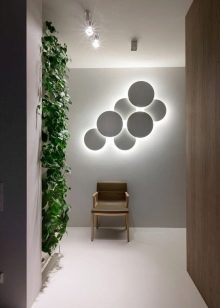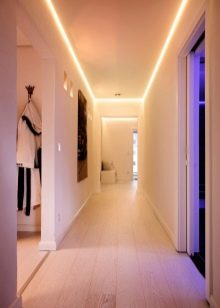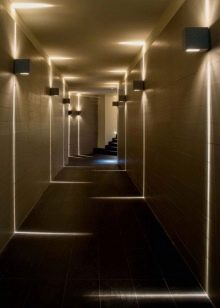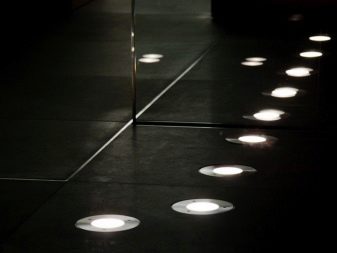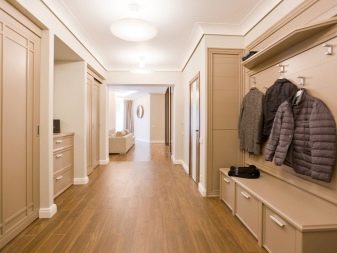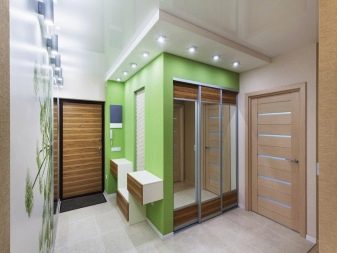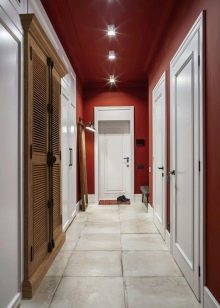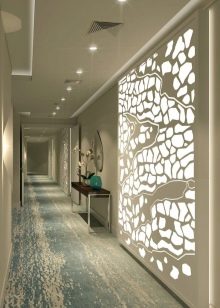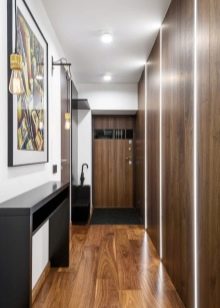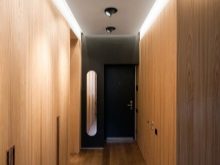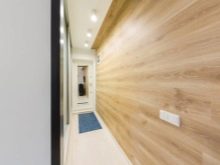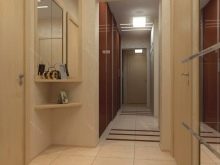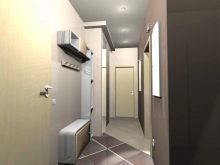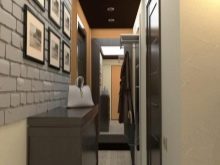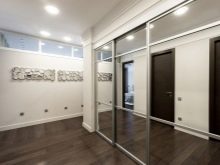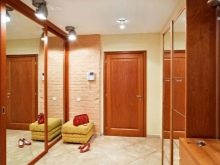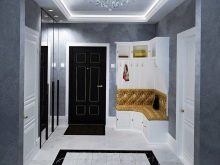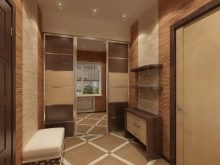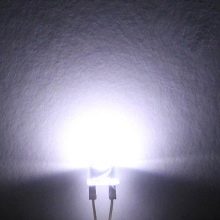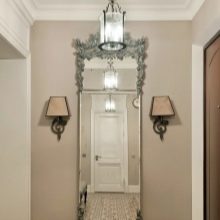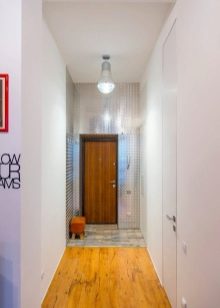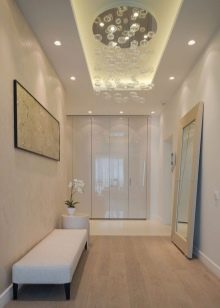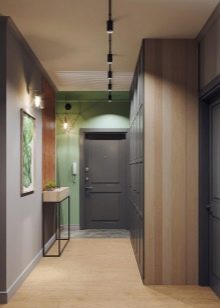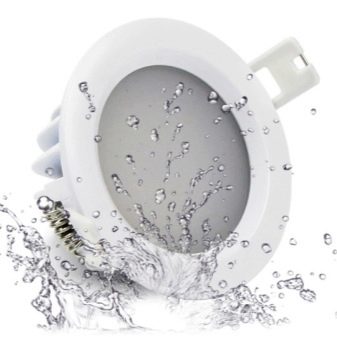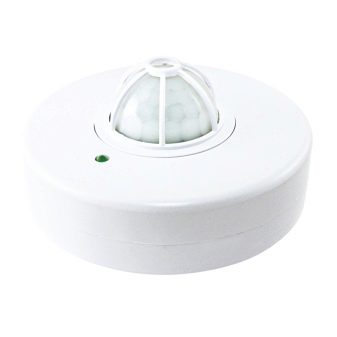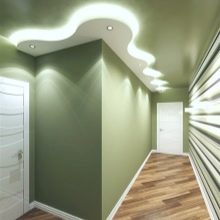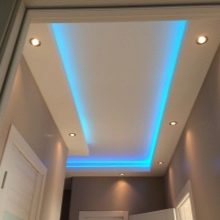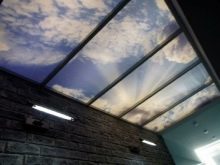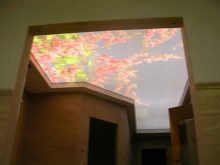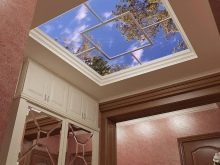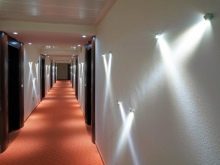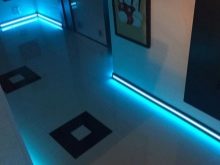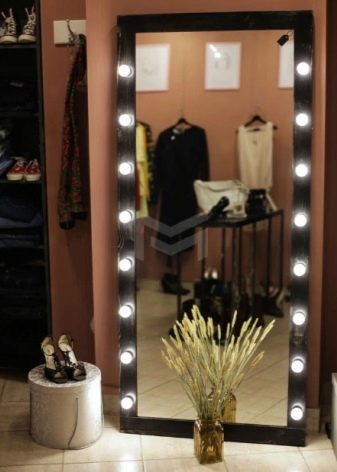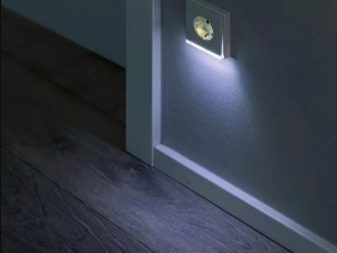Corridor Lighting Ideas
Lighting of the entrance area gives the interior a bright individuality, effectively emphasizes all the advantages of the corridor space and neutralizes its shortcomings. With the help of well-chosen lighting schemes, you can not only set a positive emotional mood, but also change the perception of the home as a whole.
General rules and requirements
In most houses, the hallways do not have windows. This is one of the darkest and smallest rooms in the house, which often resembles a gloomy box. That is why it is so important to choose the right lighting scheme for this space and equip it with maximum power lighting devices.
Designers offer general guidelines for organizing lighting in corridors.
- To create the effect of sufficient illumination in the hallways, it is better to give preference to bulbs with a white or yellow glow spectrum. A good solution would be energy-saving devices that give a matte white glow - it does not tire the eyes.
- For square spaces, it is allowed to mount one lighting fixture in the center. For narrow and elongated rooms, you will need several lamps located at an equal distance from each other.
- To visually expand the boundaries of a narrow room, it is necessary to direct the lighting to the upper half of the walls.
- Light systems look most harmonious in tandem with light wall cladding and mirrors. This technique visually pushes the boundaries of the room, fills it with space and light.
When designing a lighting scheme, it is important to take into account the height of the ceiling. In corridors with low ceilings, pendant chandeliers will be inappropriate, since such light will not provide effective illumination. In addition, when passing along the corridor, you will touch the structure with your head every time. In such a room, it is better to place wall spots, sconces and plate chandeliers.
In rooms with high ceilings, the situation is reversed. Here, flat chandeliers mounted high off the floor will provide good lighting to the ceiling itself and the upper part of the walls. But only a small fraction of the backlight will reach the main functional areas. Therefore, it is advisable to lower all lighting fixtures in order for the light accents to shift downward. A similar effect can be achieved by installing wall-mounted lighting fixtures along the perimeter of the corridor.
And, of course, the installation of lighting systems must be carried out in accordance with the rules and regulations of fire safety.
Selecting and placing a light source
Several types of lighting are allowed in the corridors. The main thing will be the main thing - it is it that dominates the entire room. A pompous massive chandelier with pendants in the corridor is unlikely to work, this option may only be appropriate in spacious rooms with high ceilings. Most often, spotlights, tablet chandeliers and sconces are mounted in the entrance area. They can be located in the center or redistributed along the entire length of the hallway. The combination of large accent lamps and several miniature ones looks very impressive.
In recent years, concealed lighting has steadily come into vogue. It is carried out along the perimeter of the entrance area, while niches are formed between the suspended ceiling and the walls, where the light sources are mounted. Concealed lighting can be implemented in one of three solutions:
- light from the cornice to the ceiling;
- light from the ceiling to the wall;
- light from the ceiling niche.
To implement basic lighting, chandeliers, spotlights and spots are mounted.
Chandeliers
Traditionally, chandeliers are used to illuminate the hallway. Ceiling luminaires for such spaces are usually compact in size. Bulky structures in a small space will only exacerbate the situation, creating the feeling of a cramped corner. It is better to choose here small flat ceiling lamps with a bright luminous flux.
It is undesirable to use models with an abundance of mounted elements. They will visually lower the ceilings and make the corridor space already small. If possible, try to use lamps that give a warm glow, while the lamps should gently diffuse it. Devices with tinted shades fully meet these requirements. You can achieve the effect of diffused lighting by directing the flow of light to the stretch glossy ceiling. From there, it will, in an already reflected form, go to the walls and floor.
Spotlights
The chandelier, so popular in the days of our grandparents, in recent years, increasingly gives way to spotlights. This is not surprising, since in a compact space, lighting devices must also be compact. Point light sources do not give a powerful flux, so they are used in large numbers. Depending on the form and functionality of the corridor zone, they can be placed both in the center of the room and closer to the perimeter.
However, when lighting stairs, they can be built in the form of an arc or a zigzag.
Spots
Spot is a cross between a traditional chandelier and spotlights. Each device includes several types of light sources, while the direction of the luminous flux can be changed. This method allows you to illuminate all the main areas and corners. In typical apartments, the corridors are usually not very large. One spot for 4-6 lamps will be quite enough here. Such lighting can be mounted as the only source of illumination, although the designers do not recommend this.
Night illumination
Many homeowners install additional lighting in the hallway, which contributes to comfortable movement at night. Most often, a diode tape is used, installed at the bottom of the walls or on the floor. LED strips are safe and ergonomic luminaires, they can be mounted along any path. They can be cold, warm shades, as well as multi-colored.
In the 80s. of the last century, neon lighting was popular. Nowadays, it has found a second life as a night illumination. The design of the lamp is a tube filled with gas - it gives a wide variety of shades of the color spectrum. Neon has become an interesting design move, if you wish, you can hide it and achieve the effect of hidden lighting.
Tip: If you need to highlight curved surfaces, you can use flexible neon.
Installing night illumination solves several problems at once:
- gives soft unobtrusive lighting that does not irritate the eyes of a half-asleep person;
- will not disturb the rest of the household if the doors to their rooms are open or have glass elements;
- saves energy due to the low power of the luminaires.
Night lighting devices are often equipped with motion sensors. In this case, the lamps will be activated only when the person is in the hallway.
This approach also allows for significant savings in electricity costs.
Additional lighting
Decorative lighting allows you to achieve the aesthetic design of the corridor room and emphasize its individuality. Usually, light panels, electric candles, neon signs, sconces, as well as LED strips are used for this. They are fixed in ceiling and floor skirting boards, above interior doors and in cabinet doors.
The corridor space looks very impressive, in which mirrors and decorative elements are decorated with garlands. They can be used to make a stylish inscription or a pattern on the wall. Hidden illumination looks spectacular, it can be implemented not only on the ceiling, but also on the walls. In this case, sconces are placed behind specially constructed decorative structures - as a result, a very original light effect is obtained.
Light floors look invariably attractive, this is one of the latest design trends. This technique involves the installation of square LED modules in the floor surface. They can be used to design a track or lay out in the form of a geometric pattern. In any case, such a solution will look original. Although to date, this method of lighting in apartment decor has not yet found widespread use in residential apartments.
Features of lighting corridors of different shapes
The corridor in apartments and houses can have different shapes and sizes. There are small and spacious spaces, square, elongated and narrow - each offering a different lighting option. A well-chosen organization of the lighting allows you to make the room functional and visually adjust the volume of space.
Long
The elongated corridor looks narrow, elongated and gloomy. In order to visually expand it and fill it with light, it is better to give preference to miniature, but at the same time extremely bright ceiling lamps. Lighting devices should be fixed along the entire length of the hallway along the line, in a checkerboard pattern, or placed randomly. Wall sconces in combination with discreet wall cladding allow to advantageously beat the shape of the corridor.
Such a tandem adds volume to the room, fills it with a feeling of lightness.
You can adjust the space by mounting a bright light source in the center and light shading in the corners. This solution allows you to give the room more correct proportions and make it comfortable. It is possible to visually expand the corridor due to the fixed transversely elongated lamps.
Tip: When organizing lighting in a long corridor, it is advisable to install two switches - at the very beginning of the room and at the end. In this case, the user does not have to cover the entire distance in order to turn on or off the backlight.
Narrow
The main problem of any narrow hallway is psychological discomfort. People have a feeling of being in a confined space. Therefore, the organization of lighting in such corridors should aim at visual expansion of the space. A good effect in this case is given by the technique of reflection and counter placement of low-power LED lamps. It allows you to create light zones in all areas where you want to create accents. In this case, it is necessary to take into account the location of all elements that can interfere with the distribution of light.
The owners of "Khrushchevs" with their small corridors face similar problems. For their illumination, lightweight ceiling chandeliers in combination with several spotlights are optimal. If the ceiling covering does not allow installing LED lighting, then you can complement the classic chandelier with several wall sconces in the appropriate stylistic design.
It is imperative that there are no shadows and darkened corners in narrow and small hallways. The luminous flux from the lamps on the ceiling should be oriented in one direction. The light from the wall sconces should be directed upwards. If you plan to place a wardrobe in such a space, then be sure to supplement it with built-in lamps.
L-shaped
In L-shaped rooms, it is necessary to use several lighting methods. For this, the space is conventionally divided into separate functional zones. The main light source is mounted right next to the front door.
For mirrors, cabinets and far corners, local illumination is used - in these areas, built-in light panels, placed perpendicular to each other, will be an ideal solution.
Square
A square room gives the impression of excessive space. Because of this, when decorating accents, the walls of the room are lost, and the opposite effect of losing free space is achieved. Hanging chandeliers will help to solve this problem; they provide uniform illumination around the entire perimeter of the entrance area. In addition to the chandelier, it is advisable to attach several additional lamps so that they illuminate all functional areas of the hallway.
Possible mistakes
It is not easy to draw up a competent layout of the lamps in the corridor; it is best to trust the designer in this matter. If you do not want to contact specialists, then you should take into account the most common mistakes that arise when arranging lighting in corridors.
Cold spectrum. You should not install cold-spectrum lamps in the corridors if the interior does not imply their deliberate use. The cold glow is uncomfortable and uncomfortable; for most people, it evokes associations with hospitals, educational institutions and other public organizations.
Unified lighting. When organizing lighting in the hallway, try to create several light zones. At the same time, they should differ in the shape of the lighting device and the type of lighting.
Ignoring the door light. For hallways with a double door, it is advisable to provide additional lighting in the inter-door space.
Sharp luminous flux. When installing spotlights, spotlights and other unidirectional light devices, you should make sure that their glow will not blind the eyes of a person at the entrance to the room.
Volumetric structures. You should not mount bulky lighting devices in the corridors if the dimensions and interior design do not require it. Any large objects visually “eat up” the usable space of an already small room.
Remember that the entrance area requires careful and frequent cleaning. Therefore, the luminaires must be water resistant. Otherwise, under the influence of moisture, they will not last long.
If you use motion sensors, then you need to configure them taking into account the composition of the family.
For example, if small children live in the house, then the sensor should respond to them, but at the same time not respond to four-legged pets that accidentally walk into the hallway at night.
Beautiful examples of interiors
Remember, the hallway is the face of the house and its owners. It is she who sets the mood when entering the room. Thinking over what impression it should make, it is important to take into account the overall design of the home as a whole and its style. The highlighting of the corridor should emphasize the design favorably, and not contrast with it.
There are many options for placing lighting systems on ceilings in hallways. These can be hanging chandeliers, track and spotlights, as well as spots.
The false window looks very impressive.
You can visually adjust the volume of the room by lighting the walls. For this, light panels, LED strips, decorative light objects and sconces are used.
In recent years, floor lighting has been used in modern designs.
Particular attention should be paid to decorative lighting, mainly for illuminating mirrors. Most often, the mirror is highlighted with an LED strip or lamps are installed on the sides.
Duty night illumination of the corridor has become widespread. It is important that soft, subdued beams are used here that do not blind the eyes. At the same time, the rays should be sufficient so that a person does not feel like moving in pitch darkness.



